BDOL Interactive Chalkboard - PowerPoint PPT Presentation
1 / 36
Title:
BDOL Interactive Chalkboard
Description:
... of Heredity. and. Human Genetics _illustrate inheritance. Male. Female ... for recessive allele. Death. Human Genetic Disorders. Recessive Disorders ... Human ... – PowerPoint PPT presentation
Number of Views:229
Avg rating:3.0/5.0
Title: BDOL Interactive Chalkboard
1
Chapter 12
Patterns of Heredity and Human Genetics
2
Male
Parents
Siblings
Female
____________illustrate inheritance
Affected male
Known heterozygotes for recessive allele
Affected female
Mating
Death
3
(No Transcript)
4
Human Genetic Disorders
5
Recessive Disorders
- Most genetic disorders are caused by recessive
alleles.
__________________ __________________ ____________
______
6
Cystic fibrosis
- Approximately one in 28 white Americans carries
the recessive allele, and one in 2500 children
born to white Americans inherits the disorder.
- Due to a defective protein in the plasma
membrane, cystic fibrosis results
__________________________________________________
______________________
7
(No Transcript)
8
Tay-Sachs disease
- Tay-Sachs (tay saks) disease is a recessive
disorder of the central nervous system.
- In this disorder, a recessive allele results in
the_______________________________________________
__________________________________________________
___________
- Because this lipid fails to break down properly,
it accumulates in the cells.
9
(No Transcript)
10
Phenylketonuria
- Phenylketonuria (fen ul kee tun YOO ree uh), also
called (PKU), is a recessive disorder that
results from the _________________________
__________________________________________________
__________________________
- Because phenylalanine cannot be broken down, it
and its by-products accumulate in the body and
result in severe damage to the central nervous
system.
11
Phenylketonuria
Phenylketonurics Contains Phenylalanine
12
Dominant Disorders
- Many traits are inherited just as the rule of
dominance predicts.
______________________________________
13
Huntingtons disease
- Huntingtons disease is a lethal genetic disorder
caused by a rare dominant allele.
- __________________________________________________
__________________.
- But because the onset of Huntingtons disease
usually occurs between the ages of 30 and 50, an
individual may already have had children before
knowing whether he or she is affected.
14
(No Transcript)
15
Treacher Collins Syndrome
- Dominant disorder that results in
_____________________________ - Wide range of severity
- EXTREMELY rare
16
(No Transcript)
17
Complex Patterns of Inheritance
- Many inheritance patterns are more complex than
those studied by Mendel.
__________________________________________________
__________________________
18
Incomplete dominance
- When traits are inherited in an ___________
________________ pattern, however, the phenotype
of heterozygous individuals is between those of
the two homozygotes.
19
Codominance
- ________________________cause the phenotypes of
both homozygotes to be produced in heterozygous
individuals. In codominance, both alleles are
expressed equally.
20
Sickle-cell disease (Codominance)
- In an individual who is homozygous for the
sickle-cell allele, the oxygen-carrying protein
hemoglobin differs by one amino acid from normal
hemoglobin.
- This defective hemoglobin forms __________
_____________________________________
__________________________________. Normal red
blood cells are disc-shaped, but abnormal red
blood cells are shaped like a sickle, or
half-moon.
21
Sickle-cell disease
- Abnormally shaped blood cells, slow blood flow,
block small vessels, and result in tissue damage
and pain.
Normal red blood cell
Sickle cell
22
Sex determination
- In humans the diploid number of chromosomes is
46, or 23 pairs.
- There are 22 pairs of homologous chromosomes
called _____________. Homologous autosomes look
alike.
- The 23rd pair of chromosomes differs in males and
females.
- These two chromosomes, which determine the sex of
an individual, are called _________________ and
are indicated by the letters X and Y.
23
Sex determination
- If you are female, your 23rd pair of chromosomes
are homologous, XX.
X
X
Female
- If you are male, your 23rd pair of chromosomes
XY, look different.
Y
X
Male
24
Sex-linked inheritance
- Traits controlled by genes located on sex
chromosomes are called _______________.
- Because the X and Y chromosomes are not
homologous, the Y chromosome has different genes
than the X chromosome .
- X-linked traits are much more common for males
than females (Examples color blindness
balding)
25
Red-green color blindness
- People who have red-green color blindness cant
differentiate these two colors. Color blindness
is caused by the inheritance of a recessive
allele at either of two gene sites on the X
chromosome.
26
25
6
8
3
27
Polygenic inheritance
- _________________________is the inheritance
pattern of a trait that is controlled by two or
more genes.
- The genes may be on the same chromosome or on
different chromosomes, and each gene may have two
or more alleles.
- The result is that the phenotypes usually show a
continuous ___________________ from the minimum
value of the trait to the maximum value.
28
(No Transcript)
29
Human Chromosomal Disorders
30
Abnormal of Autosomes
- Humans who have an extra whole or partial
autosome are __________that is, they have three
of a particular autosomal chromosome instead of
just two. In other words, they have 47
chromosomes. - Individuals with only 1 copy of a chromosome is
called ___________ (45 total chromosomes)
- To identify an abnormal number of chromosomes, a
sample of cells is obtained from an individual or
from a fetus.
31
Abnormal of Autosomes
- This chart of chromosome pairs is called a
___________, and it is valuable in identifying
unusual chromosome numbers in cells.
32
Down syndrome Trisomy 21
- Down syndrome is the only autosomal trisomy in
which affected individuals survive to adulthood.
- It occurs in about one in 700 live births.
33
Down syndrome Trisomy 21
- Down syndrome is a group of symptoms that results
from trisomy of chromosome 21.
- Individuals who have Down syndrome have at least
some degree of mental retardation.
- The incidence of Down syndrome births is higher
in older mothers, especially those over 40.
34
Abnormal of Sex Chromosomes
- Many abnormalities in the number of sex
chromosomes are known to exist.
- An X chromosome may be missing (designated as XO)
or there may be an extra one (XXX or XXY). There
may also be an extra Y chromosome (XYY).
35
Down syndrome
normal male
X individual
Xyy individual
36
__________________________________________________
_________































